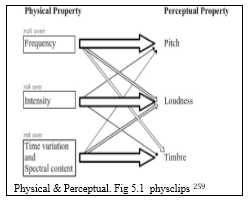The physical quantifiable tonal qualities of the Stuart and Steinway sounds presented in chapter four are based on the spectral and temporal measurements of the time varying amplitudes of each partial frequency of single notes, sounded by calibrated levels of velocity key strike. The writers Wolfe and Meyer256 (see chapter 3), describe timbre as a combination of spectral and temporal elements of specific frequency and loudness, analysed at a point in time in the duration of the sound.257 The table below, supplied by the UNSW Physics department, shows the interactive elements that combine to produce timbre, based on the purely sonic components.

The piano sounds evaluated by the audiences in the Piano Contrasts concert-surveys are heard as multiples of the single-complex notes examined previously in chapter four, because in music performance practice piano notes are heard/played in combinations, vertically in chords and clusters or linearly in melodic phrases. The harmonic qualities of sounds produced in music performance are therefore produced by simultaneously sounding and pitch shifting fundamental tones, each sounding their particular series of harmonics, combined in varying magnitudes of resonance. In addition to this, the musical performance setting brings the psychophysical participation of the individual musicians and audiences to the evaluation of the multidimensional sonic elements.
The collective qualities of the sound of groups of musical notes was first discussed by Herman Helmholtz in his On The Sensations of Tone259 , where he documented his discoveries of the derivations of instrumental tone in the resonances of combined tones. J. Roederer explains the phenomenon of Helmholtz’s discoveries –
When two complex tones of different pitch are superimposed, either of two situations may arise: The fundamental frequency of the higher tone is equal to one of the upper harmonics of the lower tone, or it is not. In the first case, the upper tone will reinforce certain upper harmonics of the lower tone, … in the second case, each of the tones produces its own multiplicity of resonances regions.260
256 10Meyer,30.
257 6Wolfe, Pyshclips,accessed 21st May, 2015.
258ibid
259 3




